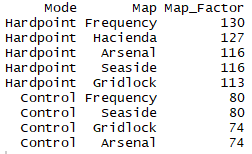
Map Factors (aka Baseball Park Factors in CoD)
With the release of every Call of Duty title, we are introduced to a variety of new maps that will comprise the map rotation for competitive play. Whether it’s a big map, a small map, a map with a lot of long sightlines, or a map with a lot of close-quarter action, we must account for the differences in the average number of engagements that occur on each map in our statistics. Also playing a huge factor: Vetoes. Vetoes allow teams to completely avoid certain maps while playing other maps a vast majority of the time. In previous titles, we may have assumed that all teams would play each map equally, but that is not the case anymore.
Park Factors
Similar to the how every map is different in Call of Duty, every baseball park is different in Major League Baseball. Coors Field, home field of the Colorado Rockies in Denver, Colorado, is the most well-known example of how much different baseball parks can be. At about 1600 meters above sea level, Coors Field is the highest park in the MLB and has a reputation of being a “hitter-friendly” park because of how much the baseball can carry in the low air density and high elevation. In baseball, the method of standardizing stats, usually runs scored, between parks is the use of Park Factors (PF). Park Factor indicates the difference between the runs scored in a team's home and road games, but is often used to adjust other stats. The formula for PF is the following:

Park Factors Formula
All the runs scored by or against a team per game at home are divided by all runs scored per game on the road. Parks with a PF > 100 average more runs per game by all teams than those teams average at all other parks. From 2010-2016, Coors Field had the highest park factor in the MLB at 138, far and away from Miller Park in second place at 118. This means that at Coors Field, teams scored 1.38x the runs they would at any other stadium.
How does it relate to Call of Duty Stats?
Useful stats that we track such as Engagements Per Minute (EPM), Kills Per Minute (KPM), and Damage Per Minute (DPM), are all impacted by the maps a team plays. For example, take a look at the Top 5 Teams in Respawn EPM at the CWL Pro League Qualifier from a couple of weeks ago.

EPM Top 5 from codstats.gg
Heretics were #2 in Team Respawn EPM. At first glance, many would believe this is a result of the team playing very aggressively; however, there is an underlying factor to these numbers that inflate them slightly. Heretics played Frequency seven different times in respawns at the PLQ (4 Hardpoint, 3 Control), or 47% of their respawn maps, more than any other team at the event. Anyone who has played a game on Frequency can tell that is a small map that promotes a lot of close-quarter gunfights, meaning players will naturally get into more engagements than on other maps.
Map Factors
By using Map Factors we can account for the maps (and modes) that each player plays on when calculating their stats. No longer will someone who plays more Hardpoints or more Frequency maps have inflated Engagement or Damage numbers. The formula for Map Factor is the following:
Map Factor (for Map X) = 100 * (EPM on Map X / EPM on All Other Maps)
After running through the data from the Pro League Qualifier, here are the map factors for each Map/Mode combination:

Map Factor Ratings from codstats.gg
As we predicted, the engagement heavy Frequency Hardpoint and Frequency Control come out on top of their respective game modes in Map Factor.
After adjusting EPM, we will now call this EPM+, using the Map Factors for the Pro League Qualifier, we see that Heretics drops all the way to 15th. No longer are their engagements numbers inflated because of all of their games played on Frequency.

EPM+ Top 15 from codstats.gg
Map Factors allow engagements, as well as other key statistics, to be standardized based on map and game mode so that we can more accurately compare player performances.